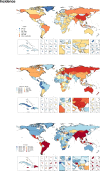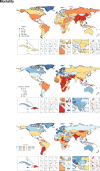Morbidity and mortality from road injuries: results from the Global Burden of Disease Study 2017
- PMID: 31915274
- PMCID: PMC7571357
- DOI: 10.1136/injuryprev-2019-043302
Morbidity and mortality from road injuries: results from the Global Burden of Disease Study 2017
Erratum in
-
Correction: Morbidity and mortality from road injuries: results from the global Burden of Disease Study 2017.Inj Prev. 2020 Oct;26(Supp 1):i163. doi: 10.1136/injuryprev-2019-043302corr1. Epub 2020 Sep 28. Inj Prev. 2020. PMID: 32989005 Free PMC article. No abstract available.
Abstract
Background: The global burden of road injuries is known to follow complex geographical, temporal and demographic patterns. While health loss from road injuries is a major topic of global importance, there has been no recent comprehensive assessment that includes estimates for every age group, sex and country over recent years.
Methods: We used results from the Global Burden of Disease (GBD) 2017 study to report incidence, prevalence, years lived with disability, deaths, years of life lost and disability-adjusted life years for all locations in the GBD 2017 hierarchy from 1990 to 2017 for road injuries. Second, we measured mortality-to-incidence ratios by location. Third, we assessed the distribution of the natures of injury (eg, traumatic brain injury) that result from each road injury.
Results: Globally, 1 243 068 (95% uncertainty interval 1 191 889 to 1 276 940) people died from road injuries in 2017 out of 54 192 330 (47 381 583 to 61 645 891) new cases of road injuries. Age-standardised incidence rates of road injuries increased between 1990 and 2017, while mortality rates decreased. Regionally, age-standardised mortality rates decreased in all but two regions, South Asia and Southern Latin America, where rates did not change significantly. Nine of 21 GBD regions experienced significant increases in age-standardised incidence rates, while 10 experienced significant decreases and two experienced no significant change.
Conclusions: While road injury mortality has improved in recent decades, there are worsening rates of incidence and significant geographical heterogeneity. These findings indicate that more research is needed to better understand how road injuries can be prevented.
Keywords: burden of disease; descriptive epidemiology; motorcycle; road injuries, pedestrian injuries; road traffic accident; traumatic brain injury.
© Author(s) (or their employer(s)) 2020. Re-use permitted under CC BY. Published by BMJ.
Conflict of interest statement
Competing interests: SLJ reports grants from Sanofi Pasteur outside the submitted work. TRM reports a contract to evaluate AB InBev Foundation’s efforts to, among other things, reduce impaired driving in 6 cities using GBD road safety data in calculating baseline harm.
Figures





References
-
- Salomon JA, Murray CJL. The epidemiologic transition revisited: compositional models for causes of death by age and sex. Popul Dev Rev 2002;28:205–28. 10.1111/j.1728-4457.2002.00205.x - DOI
-
- WHO Decade of action for road safety 2011-2020. WHO. Available: http://www.who.int/roadsafety/decade_of_action/en/ [Accessed 27 Jul 2019].
-
- Sustainable Development Goals Sustainable development knowledge platform. Available: https://sustainabledevelopment.un.org/?menu=1300 [Accessed 27 Jul 2019].
-
- WHO Global status report on road safety 2018. WHO. Available: http://www.who.int/violence_injury_prevention/road_safety_status/2018/en/ [Accessed 26 Jul 2019].
Publication types
MeSH terms
Grants and funding
LinkOut - more resources
Full Text Sources
Medical
